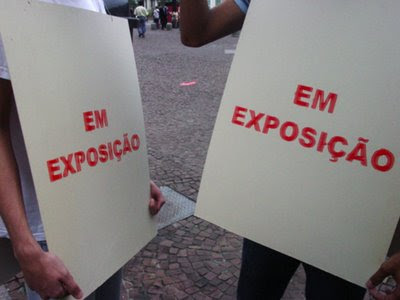
The Place for the Public Art (part 2)
Suspicious Behaviour
In 2006 the group Esqueleto Coletivo, one of the groups that been following the Prestes Maia and the whole process of gentrification in São Paulo had access to the maps of the surveillance cameras in the city center if São Paulo. The cameras has been installed since beginnings of 2006 according with officials reports from the Social Assistance Secretary the aim was to 'repress the street vendors in the city center'.
The whole system would ' help to find the leaders amongst these vendors and punish them' and eventually 'would help the people that live in the streets'. No registered film of the police operations is allowed, since its the own police that take care of the system. Severe abuses of the policemen in central São Paulo has been related, but even though are recorded in tape, no access to the information registered is given to individuals.. Tabata Costa, grupo Alerta!
Tabata Costa, grupo Alerta!
With the original maps, and subsequent cameras found, the group could trace the area that was under vigilance, and find out that it was the same area that was in the aim of the gentrified plans of the government.
Mostly of the areas in the city wanted to implement the system, but only in those areas they were put.
The group imagined what would happen if at the same time several suspicious actions took place under the surveillance cameras in the city center. does the police would have enough force to check it out everything that was going on there? Would they really care? Tranca Rua
Tranca Rua
The group join forces with another group -called EIA, and organized an open call in which everyone was invited to take part in the action. the cameras would be distributed amongst the people and each one was free to do their own suspicious action.
The idea was to decentralize the action in order to make it happen in several places at the same time.
Using surveillance cameras in art projects is not new. Since we started to research about the issue, the stronger references were the group Surveillance Cameras Players - that may be known to most of you.
The project was not supposed to oppose the cameras itself, but to call the attention for its presence, in one hand and try to get more discussion about the uses of the images captured, since it is not free access. In several occasions policial abuses were reported and surely captured with the cameras but obviously the images could never been seem for the simple fact it is kept by the own municipal guard.
So, in general, people admit the surveillance cameras is good for the city, but is not aware that their access to it is denied. Jaime Lauriano
Jaime Lauriano
The action was covered by media and was succeeded. Around 30 cameras captured at the same time the suspicious acts. Pamphlets and lot of talk with the people in the street as usual. Some police around but no confrontation. Other collectives made similar "suspicious behaviour " on other parts of Brasil, and a collective that was in Costa Rica made the action there too. Like always much talk in the Internet followed the intervention itself, especially because it was pretty much on the papers. Viviana, do Rio de Janeiro
Viviana, do Rio de Janeiro
The media coverage tried pretty much to cover the history of artivism, in order to make context with the action, which had a reaction for the collectives.
The municipal guard did not answer the release of the images, and only few months later two major incidents including the municipal guard took place in the city center, and left several people hurt: one in a Christmas party of the homeless, in which two aldermen were hurt and sprayed with pepper gas, and in other a festival of the Municipality where several people get hurt due to policial excess in a rap event.
The images officially never been released, and in the amateur filming the scenes are strikingly brutal.
more at:
http://atitude-suspeita.blogspot.com/
sexta-feira, 25 de janeiro de 2008
The place for the Public Art (part 2)
Assinar:
Postar comentários (Atom)
Nenhum comentário:
Postar um comentário